#traditional chinese
Text
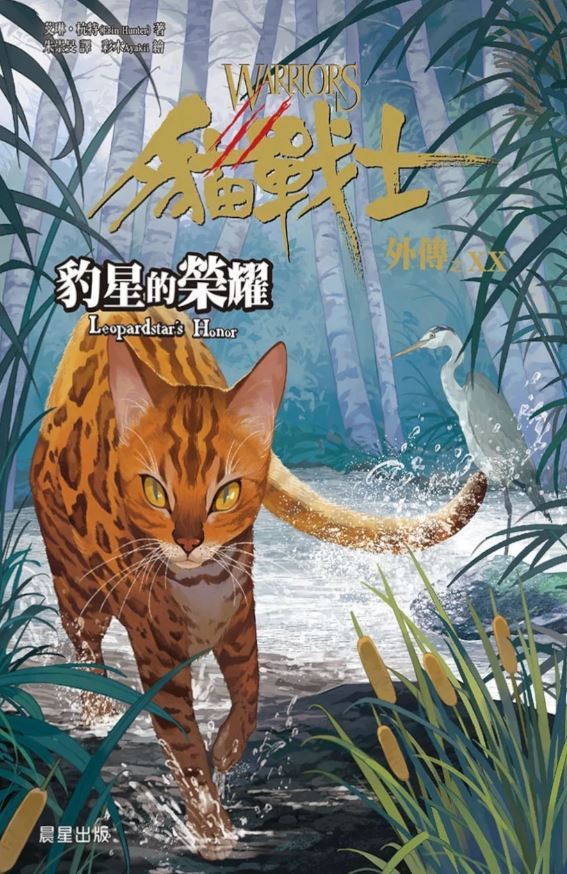
Title: Leopardstar's Honor
Arc: Super Edition
Type: cover
Country: Taiwan
Characters: Leopardstar
Source: https://warriors.fandom.com/wiki/Leopardstar%27s_Honor
705 notes
·
View notes
Text
Random Stuff #12: What is Simplified Chinese?
For people like me who grew up speaking and using Chinese in day to day life, the vast majority of us have at least a basic understanding of what Simplified Chinese is, but it wasn’t until some days ago when an English speaker asked me “what is Simplified Chinese?” that I realized not many people here understand what Simplified Chinese is. So, I’ve gathered some misconceptions I’ve encountered both in real life and online, and I will try to answer them in a concise but factual manner.
But first, let us talk basics. There are three things we must cover first before going into this topic. The first is the fact that both Simplified Chinese (简体中文) and Traditional Chinese (繁體中文) used today are modern standardized systems of written Chinese, as in both were compiled within the past 100 years or so (modern Simplified from 1935-1936, then again from 1956 and on; modern Traditional starting from 1973), and the two currently widely used versions of both systems were officially standardized in the past 50 years (modern Simplified current version standardized in 2013; modern Traditional current version standardized in 1982). However, since simplified characters already exist in history (called 简化字/簡化字 or 俗体字/俗體字/”informal characters”), and “Traditional Chinese” can be taken to mean “written Chinese used in history”, in this post I will use “modern Simplified/Traditional Chinese” or “modern Simplified/Traditional” when referring to the currently used modern standardized systems.
Second is the evolution of written Chinese. Usually when this is taught, instructors use examples of how certain characters evolved over time, for example one might encounter a linear diagram like this in Chinese class:

(Original picture from Mandarinpedia)
However, this diagram only gives a very general idea of how characters evolved from more picture-like logograms to the more abstract symbols we call characters today, and does not reflect the complexity of this evolution at all. To get into these details we will need to talk about Chinese calligraphy. In terms of the evolution of written Chinese, Chinese calligraphy--all those scripts like oracle bone script (甲骨文), bronze/Jinwen script (金文), Seal/Zhuan script (篆书/篆書), Clerical/Li script (隶书/隸書), Regular/Kai script (楷书/楷書), etc--they aren’t just calligraphy fonts, but actually change the way characters are written, and are representative of the commonly used forms of written Chinese at different points in Chinese history, as in the appearance of a certain script on a historical artifact can actually be used to estimate how old the artifact is. Below is a (very) rough timeline of when each script appeared and when they are most popular:
Oracle bone script/Jiaguwen (甲骨文): Shang dynasty (~1600 BC-1046 BC)
Bronze/Jinwen script (金文; includes Large Seal script/大篆): Western Zhou dynasty (~1046 BC-771 BC)
Seal/Zhuan script (篆书/篆書; sometimes called Small Seal script/小篆 or Qin script/秦篆): compiled in Qin dynasty by chancellor Li Si/李斯 around 221 BC, was the official script in Qin dynasty (221 BC-207 AD); popularity went down after Qin dynasty but was still in use for ceremonial purposes like official seals (the archaic meaning of 篆 is “official seal”, hence the English name); still in use today in very specific areas like seal stamps, calligraphy, logos, and art.
Clerical/Li script (隶书/隸書): appeared in Qin dynasty, became the main script used in Han dynasty (202 BC-220 AD); popularity went down after Han dynasty but was still in use; still in use today in specific areas like calligraphy, inscriptions/signatures on traditional Chinese paintings, logos, and other art.
Regular/Kai script (楷书/楷書): appeared in late Han dynasty, became the main script used in Tang dynasty and has been popular ever since (618 AD-present).
(Note: there are other calligraphy scripts like Semi-Cursive script/行书/行書 and Cursive script/草书/草書 that were never mainstream yet were also significant, especially in the case of modern Simplified Chinese, but I will mention them later so this won’t become too confusing)
So if we plug the information from the very rough timeline above into the linear diagram, it becomes this:
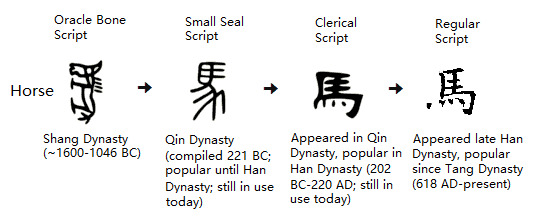
But wait! There’s even more! Because there is a thing called variant Chinese characters/异体字/異體字, which basically means that there have been multiple ways in which a character can be written (“one character, many forms”/一字多形), and these can come about as a result of homophones, personal preference of historically significant people, historical trends, mistakes in the past that stuck around, or the result of stylized scripts like Cursive script/草书/草書, which simplifies and connects strokes in a liberal manner. The reason Cursive script is important here is because of the logographic nature of written Chinese, meaning the simplifying or connecting of strokes actually changes how the character is written. Because of this, 马 and 馬 were forms that have already existed before modern Simplified and modern Traditional were compiled. A diagram that takes variations and evolution into account should look something like this:
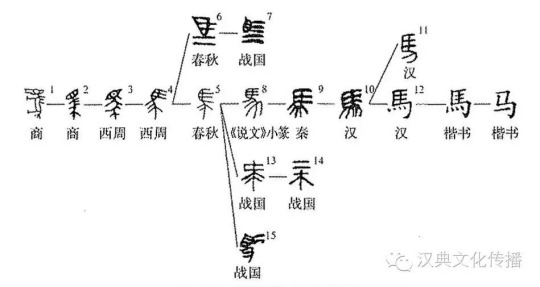
And since the above diagram did not take Cursive script into account, here’s another picture of a myriad of scripts/fonts (not in chronological order) that includes 馬 in Cursive script (mostly on bottom left):
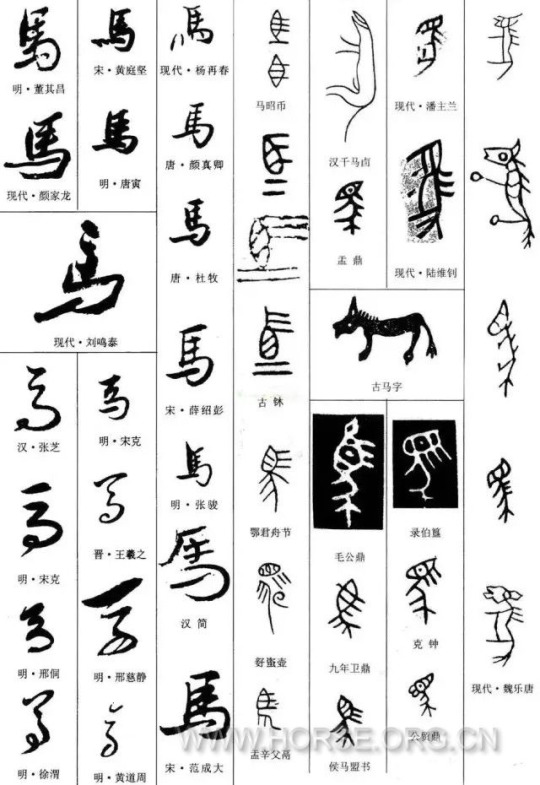
Now you may have an idea of where modern Simplified and Traditional Chinese came from: they are both compiled from existing variants. Since both modern Simplified and modern Traditional are supposed to be standardizations of written Chinese, they each set a single variant for each character as the “standard”. Modern Traditional Chinese kept the more historically mainstream 馬, and modern Simplified Chinese substituted it with the simpler variant 马. Taking all of this into account but still keeping it concise for our topic here, our linear diagram from the beginning should be modified to look like this:
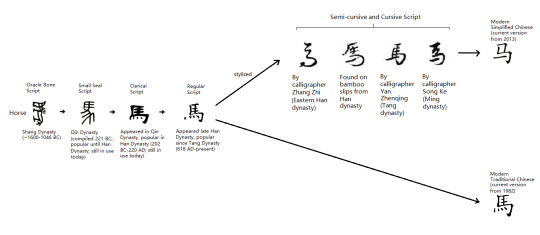
And that’s just an example of a single character. This evolution diagram can differ depending on the character too, due to there being other rules for simplifying characters. This is why standardizing written Chinese is an immense amount of work, but once standardized, the written language will be streamlined and much easier to use in communication.
Finally, we are ready to clear some misconceptions.
---------------------------------------------------
About Common Misconceptions Regarding Modern Simplified Chinese:
“Simplified Chinese replaced all Traditional Chinese characters”. Untrue. Modern Simplified Chinese only standardized 2274 of the most used Chinese characters and 14 radicals with simpler variants. That’s really all there is to it. For reference there are a total of about 60,000 Chinese characters, and about 3,500 of these are deemed to be often-used characters; so only ~3.7% of all Chinese characters and ~65% of often-used Chinese characters are simplified in modern Simplified Chinese. Play around with any online tool that can switch between modern Simplified and modern Traditional, and you will find that many characters stayed the same.
“Simplified Chinese is the opposite of Traditional Chinese”. Untrue. Modern Simplified Chinese is just a simplified and standardized system of written Chinese. Modern Simplified Chinese and modern Traditional Chinese are not “opposites” of each other at all, just different standardized systems serving different purposes. Modern Simplified was compiled with ease of use in mind, since Traditional characters can be time-consuming to write, for example imagine writing 聲 (sound) when you can just write 声 instead. Also back when Simplified was being introduced to the public, a huge part of the population was illiterate, especially farmers, poor people, and women, so Simplified Chinese was a great way to quickly educate them on reading and writing, and to improve efficiency in all aspects of life. Knowing how to read and write is key to education, and education is a must if people's lives were to be improved at all.
“Simplified Chinese is Mandarin”. Untrue. Mandarin is a spoken dialect that came from Beijing dialect, and both modern Simplified and modern Traditional Chinese are modern standardized systems of written Chinese. One concerns the written language and the other concerns a spoken dialect.
"Simplified Chinese was invented by the Communist Party". Untrue. As mentioned before, most characters used in modern Simplified Chinese are already present in ancient texts, artifacts, and inscriptions as variants. Apparently the only character simplified by PRC was 簾 (blinds/curtain), which became 帘 in modern Simplified Chinese. History wise, Republic of China was the first to start compiling Simplified Chinese in 1935 and introducing it to the public, but this was called off after 4 months. PRC modified and built on the original plan, and introduced it to the public again starting from 1956.
"Simplified Chinese is to Traditional Chinese as Newspeak is to English in 1984". Completely untrue. Modern Simplified Chinese is just a simplified way to write commonly used Chinese characters and does not alter the meaning of the characters. There are some Traditional characters that are combined as one simplified character in modern Simplified, but the meanings are not lost or altered. For example, 發 fā (development) and 髪 fà (hair) are combined as 发 in modern Simplified, resulting in 发 having 2 different pronunciations (both fā and fà), and each of these pronunciations carrying their original meaning. The meaning of neither 發 nor 髪 was lost, 发 will just have a longer dictionary entry.
"Simplified Chinese is a huge change from Traditional Chinese". Only partly true in that it is a change, but it is a change justified by the evolution of written Chinese throughout history. The origin of most modern Simplified Chinese characters come straight from history itself, since many characters had alternative ways in which they were written (sometimes for convenience), for example these characters below. Each row contains different forms of a single character (smaller characters indicate what time period these variants are from; ex: 汉碑 means the variant is from a Han dynasty inscription).
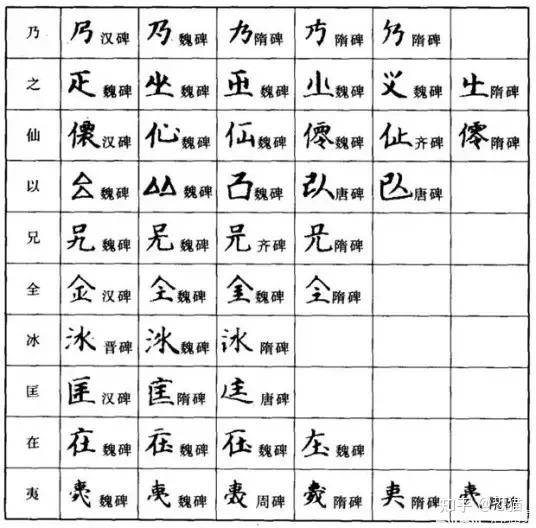
In reality, written Chinese has always been standardizing itself. Less-used variants become forgotten over time, sometimes only rediscovered through archaeology. Besides, effective written communication does partly rely on standardization of the written language (imagine everyone writing in the various variants...how horrible would that be?). Modern Simplified just took this one step farther and made some characters easier to write.
“Traditional Chinese is no longer used in Mainland China”. Untrue. Modern Simplified is the commonly used form in Mainland China, but Traditional is still used in a variety of places, such as on store signs/brand logos, particularly for stores/brand that are old. For example the old Beijing brand 天福号 below (est. 1738). On their logo, 天福号 is written as 天福號 from right to left, which is the traditional way of writing horizontally.
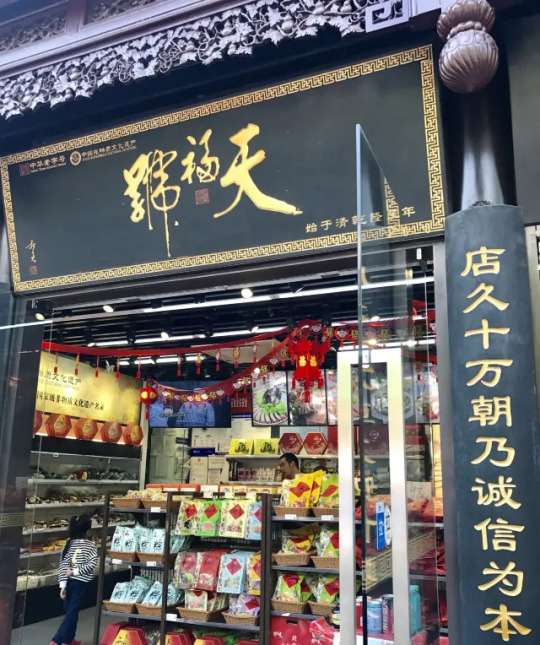
Traditional Chinese is also used in the logos for many universities in China:

Another way in which Traditional Chinese is commonly used in mainland China are personal seal stamps. Often times when people carve seal stamps for personal use (for example showing ownership on artwork they created or collected), they would put their name/courtesy name/nickname on the seal stamps in Zhuan/篆 calligraphy font, and Zhuan font use Traditional Chinese. Of course, the ways in which Traditional Chinese is still used in mainland China isn’t restricted to these two examples here. There are other places where Traditional Chinese is still used, such as traditional paintings/国画, calligraphy/书法, and many many more.
“People who grew up reading Simplified Chinese cannot read Traditional Chinese”. Depends on who you are asking. I grew up learning only modern Simplified, and I can read Traditional/modern Traditional Chinese just fine without having to actually learn it from anyone. Most people who grew up with Simplified Chinese should be able to read at least some Traditional without help. There are some people who say they can’t read Traditional without taking the time to learn it, but I doubt they’ve really tried, to be very honest.
---------------------------------------------------
And that’s it for the misconceptions!
My personal philosophy regarding modern Simplified Chinese and modern Traditional Chinese can be summed up as 识繁写简, or basically “know how to read Traditional and know how to write Simplified”. In a way, knowing how to read Traditional is a bit like knowing how to read cursive: a lot of history could be lost if we completely stopped using/learning about Traditional Chinese, but to meet the fast pace that modern life demands, I think modern Simplified Chinese is the more convenient choice for writing for day-to-day purposes. Since quite a few posts on this blog concern history, you will find that I usually use both Traditional Chinese and Simplified Chinese for historical things, since modern Traditional Chinese is closest to what people used in the past, and modern Simplified Chinese is more often used now. If it appears that I didn’t put modern Simplified and modern Traditional side by side, that usually means either the characters stayed the same and there’s no need for me to type the same thing out again, or the topic does not call for both to be shown.
Finally, the fun part. Here’s a Seal/Zhuan script calligraphy work by Mi Fu/米芾 (1051-1107):

Does something look familiar there?
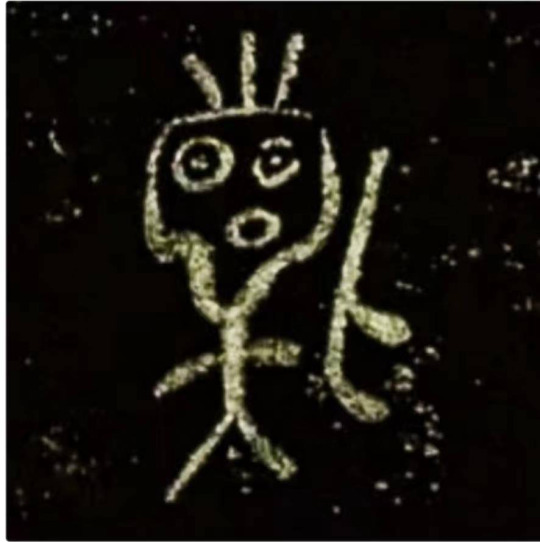
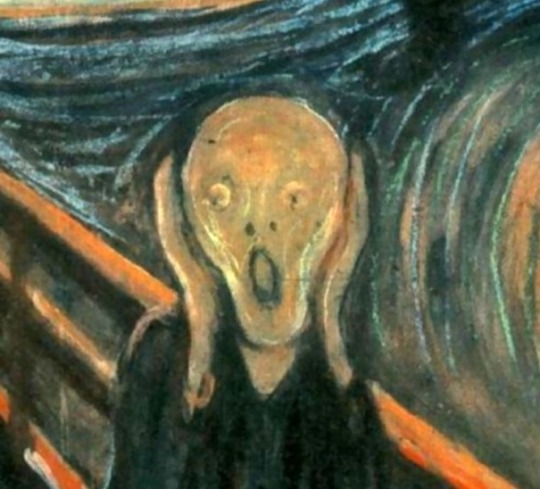
#simplified chinese#chinese language#language#written language#traditional chinese#chinese calligraphy#chinese history#random stuff#what is simplified chinese
990 notes
·
View notes
Photo

Portrait of the Sun Xiao family | inspired by real traditional family portraits! worked on this one for a few days, I wanted to draw my owl babies all together.
I really went in for the detail and authenticity. some of these I hand drew myself, while the robe patterns were edited in.
#my art#winged warriors jiang#winged warriors: the owls of sun xiao#winged warriors peiling#winged warriors zhuli#owls#anthro#digital art#traditional chinese#chinese culture#anthro ocs#furry ocs#avian furry#furry#birds#bird ocs#owl ocs#i'd love to print this and turn it into a scroll
254 notes
·
View notes
Text
Was in the middle of reading a fic when I was completely blindsided by “Mandarin people”. Referring to Chinese people who speak Mandarin. I was absolutely flabbergasted like what? I already die inside when people refer to the written aspect of Cantonese as that instead of Traditional Chinese (please, Cantonese is the dialect, not the characters. And on that vein, Mandarin is also a spoken language and its written form is Simplified Chinese because Canto is the OG) but this just took the cake. Mandarin is a language (technically a dialect too but who’s nitpicking) not a nationality?
Also there are different terms for paternal and maternal sides of the family and it is driving me absolutely crazy to see “Yéye” (爷爷: paternal grandfather) and “Năinai” (奶奶: paternal grandmother) used for mother’s parents. “Wàigōng” (外公) and “Wàipó” (外婆) are for maternal grandfather and grandmother. Literally translated, it means “outside grandfather/mother”, but the 外 (wài: outside) is often omitted and the last character is repeated to just “Gōng Gōng” and “Por Por”.
#rant#sort of psa#yes this was a maydaisy fic#no hate tho#it’s just genuinely driving me crazy#I appreciate the Chinese culture incorporation but pls ftlg do it right#it kills me inside every time I see the wrong name for grandparents#I rejoice when it’s right tho#like thank you for doing your research#Chinese things#traditional Chinese#Chinese language#Cantonese#mandarin#simplified Chinese
32 notes
·
View notes
Text
[Chinese translation] DIR EN GREY - カムイ
Translation by me.
You can read the lyrics with Kanji & Hiragana & Chinese translations at my Blogger. 👆 (Just like karaoke!)
Japanese/Traditional Chinese lyrics below 👇
憂いを貪り食う
貪婪地吞食憂傷
自覚の虜
自覺的俘虜
夢ばかりじゃ夢は朽ちる
總是處在夢境中的話 夢就會漸漸腐朽
虚な瞳に生きる
我活在空虛的眼眸裡
それが現実
這就是現實
代わり映えのない明日
一如既往的明日
夜へ
直至夜晚
誰にも言えない
無法向任何人傾訴
傷に身を投げ出して
我將自己扔進傷口之中
預けた事の無い命
從未交付過的生命
篩にかけ
我細細篩選
聞いているのは
正在聆聽的是
無慈悲の椅子
無情的椅子
虚な瞳に生きた
我一直活在空虛的眼眸裡
其処に居るのは
在那裡的還是
代わり映えのない詩
一成不變的詩歌
唄おう
來唱吧
後何年ですか?
還剩下幾年呢?
まだ生きるんですか?
還要繼續活下去嗎?
求め狂う薄情の喝采
瘋狂地尋求那些薄情的掌聲
時には涙と笑顔の真似
有時我會模仿他們的淚水和笑容
捨てられた愛を拾う人生なんです。
我的一生都在撿拾那些被拋棄的愛
首輪に鈴をつけて
我將項圈繫上鈴鐺
今日も歩く
今天也會繼續向前走
虫ケラを踏む
踩過那些螻蟻
私も同じ
我也和牠們一樣
嘆き
哀嘆
もがき
掙扎
叫び
叫喊
嬉しい?
開心嗎?
愛、投げつけられ
愛 被拋棄
命
生命
軽い
輕賤
命
生命
嘘だ
是個謊言
命奏でよう
彈奏生命吧
避けられない
逃避不了
今日も痛い
今天也好痛
傷に投げ込まれる
被扔進傷口之中
嘘だ
騙人
信じられないよ
不敢相信啊
私も人間
我也是個人
誰にも言えない
無法向任何人傾訴
傷に身を投げ出して
我將自己扔進傷口之中
嘆き
哀嘆
もがき
掙扎
叫び
叫喊
嬉しい?
開心嗎?
愛、投げつけられ
愛 被拋棄
命
生命
軽い
輕賤
命
生命
嘘だ
是個謊言
愛奏でよう
彈奏愛吧
避けられない
逃避不了
今日も痛い
今天也好痛
傷に投げ込まれる
被扔進傷口之中
嘘だ
騙人
信じられないよ
不敢相信啊
私も人間
我也是個人
生臭い空が
充滿腥臭的天空
唯一の救いだろう
或許才是唯一的救贖吧
今よりもっと人間の
我要比現在更加地
生き方に近く
活得像個人
Absolute
後何年ですか?
還剩下幾年呢?
まだ生きるんですか?
還要繼續活下去嗎?
求め狂う薄情の喝采
瘋狂地尋求那些薄情的掌聲
時には涙と笑顔の真似
有時我會模仿他們的淚水和笑容
捨てられた愛を拾う人生なんです。
我的一生都在撿拾那些被拋棄的愛
時には温もりと
有時我感覺到帶著溫暖
安らかな死の匂いを
安詳的死亡氣息
#dir en grey#diru lyrics#diru lyrics translation#translation by yinfu#kamuy#chinese translation#中文翻譯#diru歌詞翻譯#traditional chinese#繁體中文#link post#link to my blogger
11 notes
·
View notes
Text
AAAAAAAAAAA
中文... aaaAA

#language learning#learning Chinese#learning languages#chinese#taiwan#taiwanese#traditional chinese#chinese script#blue learns chinese
3 notes
·
View notes
Photo



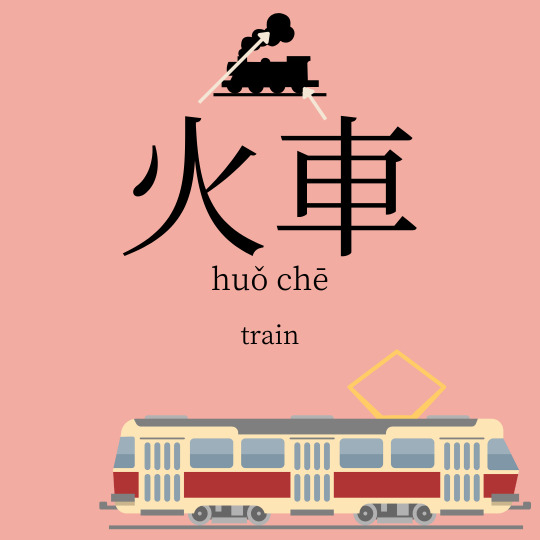
public transport related chinese vocab (traditional characters/taiwanese mandarin)
#langblr#Chinese Vocabulary#chinese langblr#chinese vocab#traditional chinese#traditional chinese characters#language learning#chinese language learning
31 notes
·
View notes
Text
[Mandarin->English] @byvoid September 29th 2016 Instagram Post - Color Coded Translation
Link to original post

—
阿巴拉契亞山脈東部邊緣的哈里斯堡,賓夕法尼亞首府 #哈里斯堡 #賓夕法尼亞 #阿巴拉契亞
阿巴拉契亚山脉东部边缘的哈里斯堡,宾夕法尼亚首府 #哈里斯堡 #宾夕法尼亚 #阿巴拉契亚
ā bā lā qì yà shān mài dōng bù biān yuán de hā lǐ sī bǎo,bīn xī fǎ ní yà shǒu fǔ #hā lǐ sī bǎo #bīn xī fā ní yà #ā bā lā qì yà
(On) the eastern fringes of the Appalachian mountain range is Harrisburg, Pennsylvania’s capital #Harrisburg #Pennsylvania #Appalachia
—
Please correct me if I made a mistake.
#color coded translation#polyglot thought translation#chinese langblr#learn chinese#chinese lesson#mandarin langblr#chinese vocab#chinese to english#taiwanese mandarin#mandarin vocab#easy mandarin#mandarin lesson#mandarin learning#study mandarin#beginner chinese#traditional chinese#study chinese#american culture#appalachian culture#appalachia#appalachian mountains#mandarin vocabulary#chinese vocabulary
17 notes
·
View notes
Photo

OH NO MO RAN YOU DIDN'T
#2ha#he just loves his shizun ok#traditional chinese#shizun#writing#chinese#gonzo calligraphy#this is like gonzo journalism but
9 notes
·
View notes
Text

Title: Graystripe's Vow
Arc: Super Edition
Type: cover
Characters: Graystripe
Country: Taiwan
Source: https://warriors.fandom.com/wiki/Graystripe's_Vow?so=search
120 notes
·
View notes
Text
youtube
#funeral rituals#rituals#traditional chinese#traditional chinese art#traditional chinese medicine#funeral#traditional#Youtube
2 notes
·
View notes
Photo
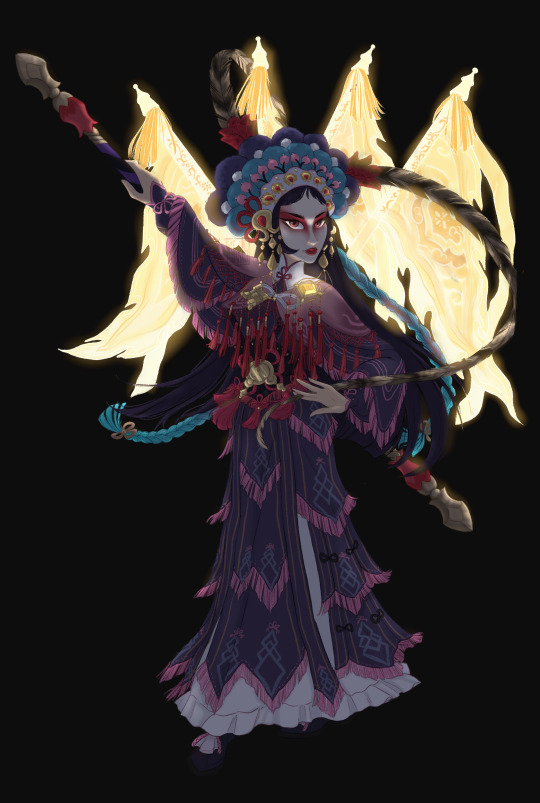
Yunjin in a traditional opera costume
#yunjin#genshin impact#genshin impact fanart#chinese opera#traditional chinese#liyue#fanart#digital art#artists on tumblr
15 notes
·
View notes
Photo
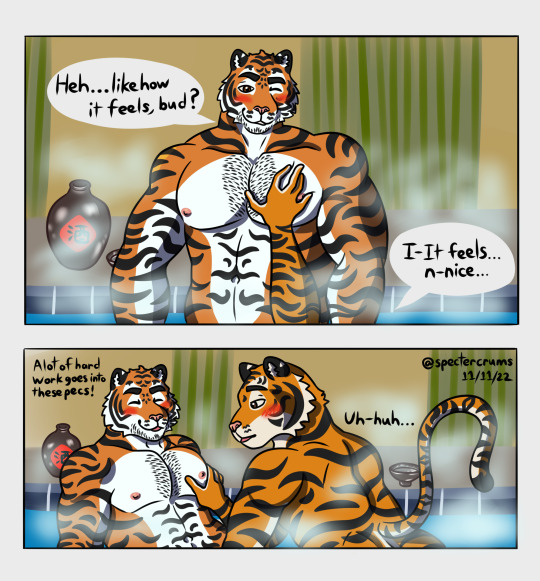
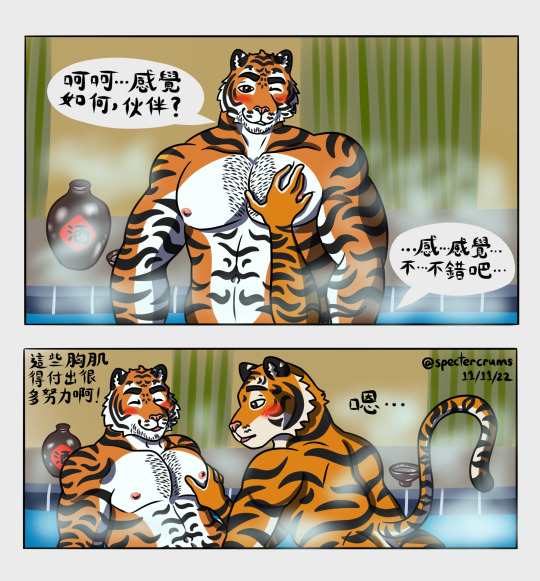
A flashback to Mengben/Biao Zhiyong's 19th birthday. To celebrate reaching the legal drinking age in Shanzun, Yijun reserves a private hot spring for the two of them and give him the first taste of alcohol. Some shenanigans occur!
#mengben#yijun#tiger#stripes#steam#hot spring#bath#wine#shaoxing wine#pec grab#pecs#traditional chinese#chinese#cup#comic#blush#gay#very gay#incredibly super gay
4 notes
·
View notes
Text
【中譯】薫の読弦--第零章「憧人」
歡迎到我的Blogger上閱讀《讀弦》的中文翻譯~
這一章中薰寫下了當年他是怎麼從認識X,愛上Hide,到後來開始彈吉他、想要組樂團,之後意外失去和Hide見面的機會,到最後終於和 Hide相見的過程。
--- ---
You can also find the English translation on Tumblr
Kaoru no Dokugen - Chapter 0: The person I admire
👉 part 1. & part 2. & part 3.
#dir en grey#kaoru#薰#dokugen#読弦#akogareru hito#憧人#kaoru translation#hide#x japan#chinese translation#中文翻譯#繁體中文#traditional chinese#translation by yinfu#link post#link to my blogger
8 notes
·
View notes
Text
My new favourite past time is to go to the wikipedia, look for a topic im interested in, and then changing it to chinese
I then obviously add them to a powerpoint like this
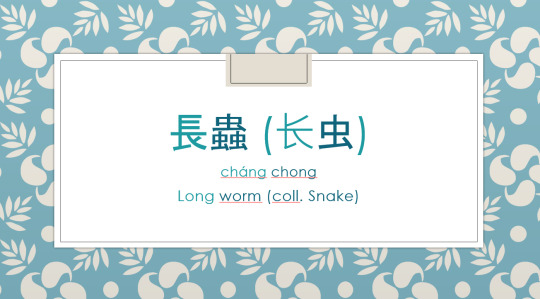
#chinese#chinese langblr#langblr chinese#mandarin langbl#mandarin studyblr#traditional chinese#simplified chinese
2 notes
·
View notes
Text
TraditumChinesic

TraditumChinesic is a xenogender (Audiogender - Musicagender) that is connected to or in some way influenced by chinese traditional music/songs. One can feel as if their gender is related to instruments, bands, or even songs that are a part of this genre, as well as musical aesthetics of the genre.

#chinese music#chinese instruments#chinese songs#musicagender#xenogender#audiogender#traditional music#traditional chinese#traditum genders#traditumchinesic#traditum
2 notes
·
View notes